CHEVROLET KODIAK 2007 Owners Manual
Manufacturer: CHEVROLET, Model Year: 2007, Model line: KODIAK, Model: CHEVROLET KODIAK 2007Pages: 430, PDF Size: 6.06 MB
Page 311 of 430
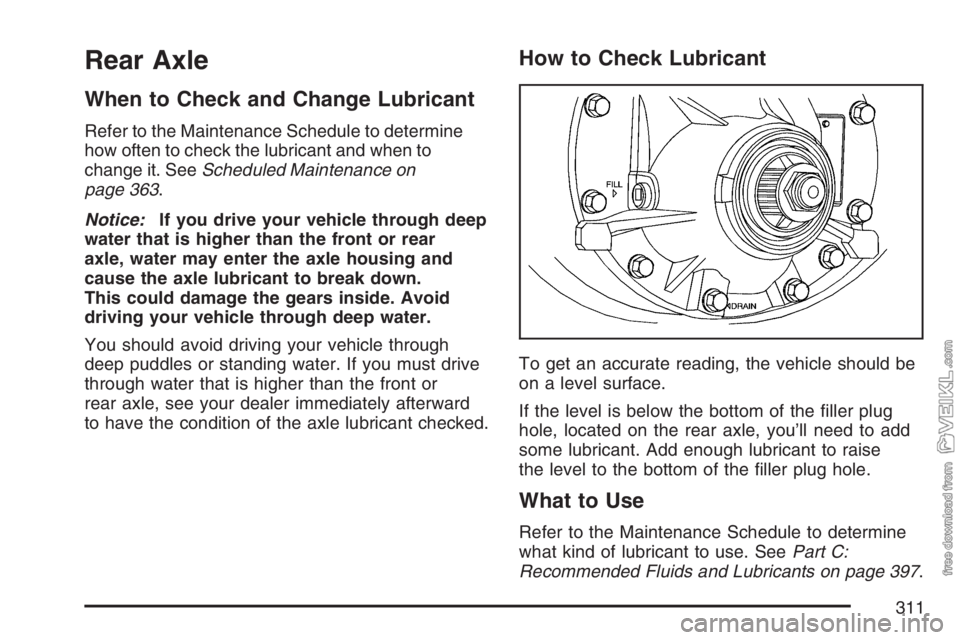
Rear Axle
When to Check and Change Lubricant
Refer to the Maintenance Schedule to determine
how often to check the lubricant and when to
change it. SeeScheduled Maintenance on
page 363.
Notice:If you drive your vehicle through deep
water that is higher than the front or rear
axle, water may enter the axle housing and
cause the axle lubricant to break down.
This could damage the gears inside. Avoid
driving your vehicle through deep water.
You should avoid driving your vehicle through
deep puddles or standing water. If you must drive
through water that is higher than the front or
rear axle, see your dealer immediately afterward
to have the condition of the axle lubricant checked.
How to Check Lubricant
To get an accurate reading, the vehicle should be
on a level surface.
If the level is below the bottom of the filler plug
hole, located on the rear axle, you’ll need to add
some lubricant. Add enough lubricant to raise
the level to the bottom of the filler plug hole.
What to Use
Refer to the Maintenance Schedule to determine
what kind of lubricant to use. SeePart C:
Recommended Fluids and Lubricants on page 397.
311
Page 312 of 430
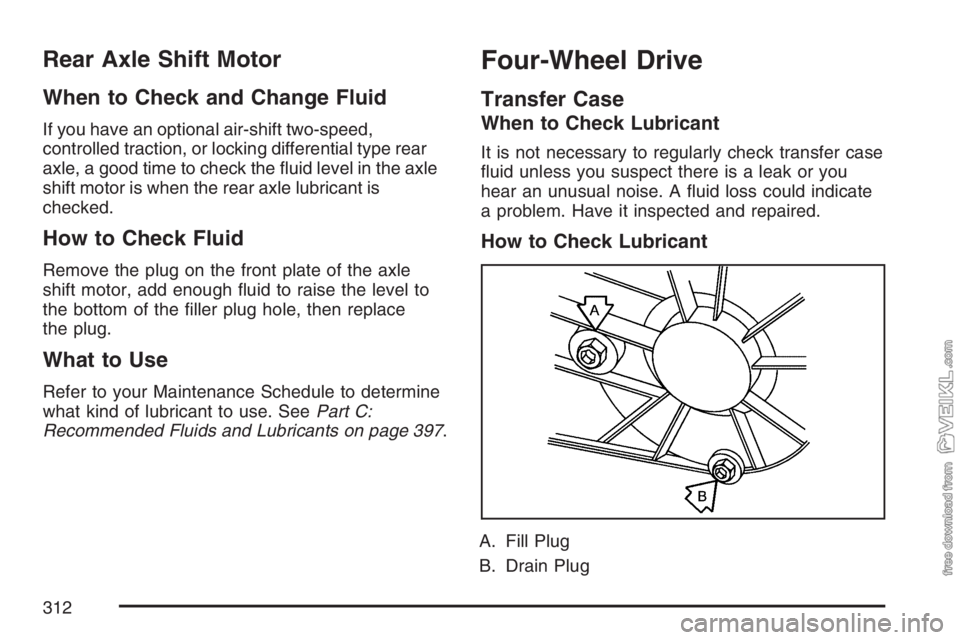
Rear Axle Shift Motor
When to Check and Change Fluid
If you have an optional air-shift two-speed,
controlled traction, or locking differential type rear
axle, a good time to check the fluid level in the axle
shift motor is when the rear axle lubricant is
checked.
How to Check Fluid
Remove the plug on the front plate of the axle
shift motor, add enough fluid to raise the level to
the bottom of the filler plug hole, then replace
the plug.
What to Use
Refer to your Maintenance Schedule to determine
what kind of lubricant to use. SeePart C:
Recommended Fluids and Lubricants on page 397.
Four-Wheel Drive
Transfer Case
When to Check Lubricant
It is not necessary to regularly check transfer case
fluid unless you suspect there is a leak or you
hear an unusual noise. A fluid loss could indicate
a problem. Have it inspected and repaired.
How to Check Lubricant
A. Fill Plug
B. Drain Plug
312
Page 313 of 430
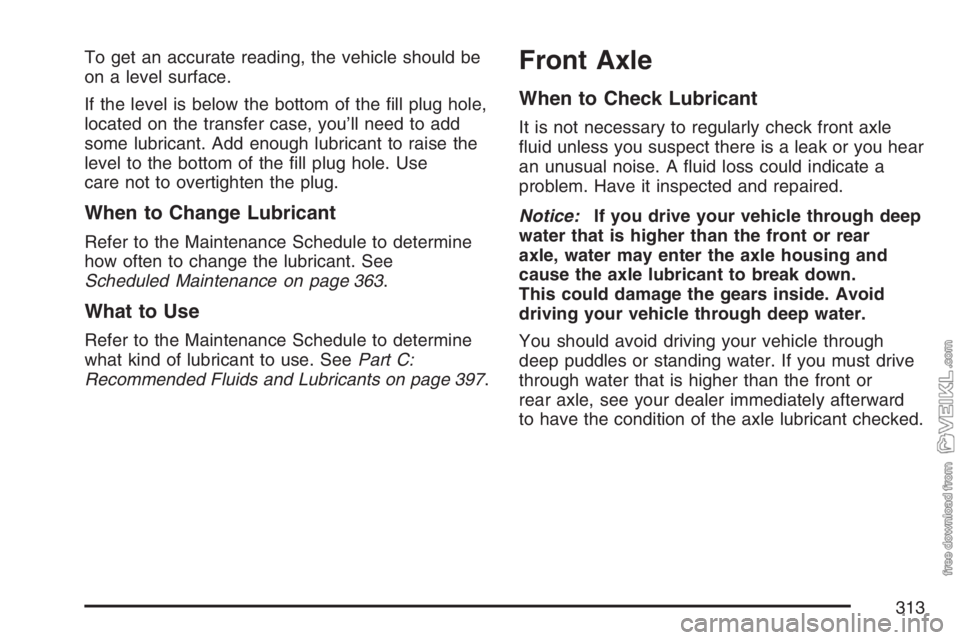
To get an accurate reading, the vehicle should be
on a level surface.
If the level is below the bottom of the fill plug hole,
located on the transfer case, you’ll need to add
some lubricant. Add enough lubricant to raise the
level to the bottom of the fill plug hole. Use
care not to overtighten the plug.
When to Change Lubricant
Refer to the Maintenance Schedule to determine
how often to change the lubricant. See
Scheduled Maintenance on page 363.
What to Use
Refer to the Maintenance Schedule to determine
what kind of lubricant to use. SeePart C:
Recommended Fluids and Lubricants on page 397.
Front Axle
When to Check Lubricant
It is not necessary to regularly check front axle
fluid unless you suspect there is a leak or you hear
an unusual noise. A fluid loss could indicate a
problem. Have it inspected and repaired.
Notice:If you drive your vehicle through deep
water that is higher than the front or rear
axle, water may enter the axle housing and
cause the axle lubricant to break down.
This could damage the gears inside. Avoid
driving your vehicle through deep water.
You should avoid driving your vehicle through
deep puddles or standing water. If you must drive
through water that is higher than the front or
rear axle, see your dealer immediately afterward
to have the condition of the axle lubricant checked.
313
Page 314 of 430
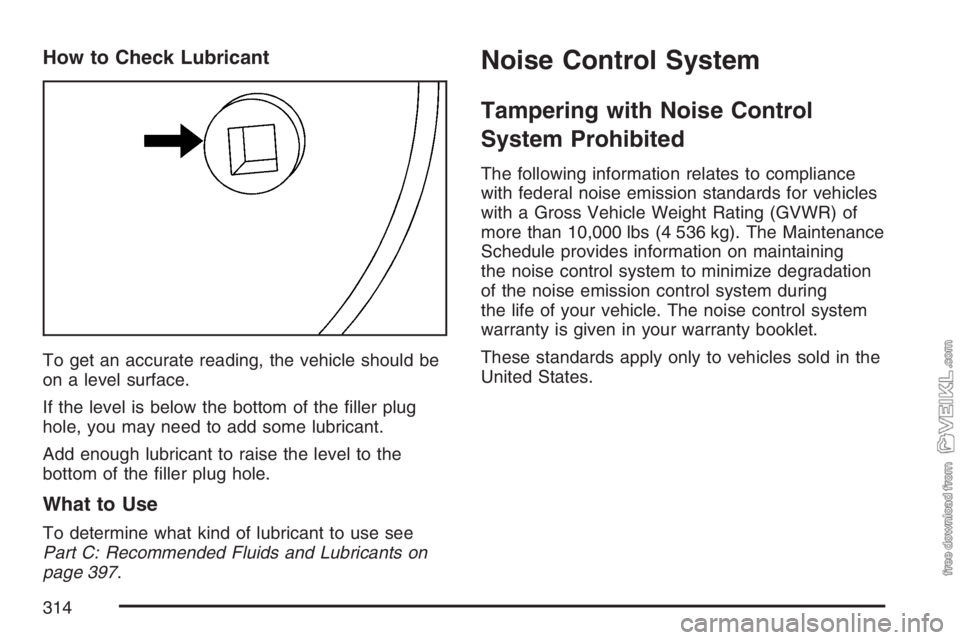
How to Check Lubricant
To get an accurate reading, the vehicle should be
on a level surface.
If the level is below the bottom of the filler plug
hole, you may need to add some lubricant.
Add enough lubricant to raise the level to the
bottom of the filler plug hole.
What to Use
To determine what kind of lubricant to use see
Part C: Recommended Fluids and Lubricants on
page 397.
Noise Control System
Tampering with Noise Control
System Prohibited
The following information relates to compliance
with federal noise emission standards for vehicles
with a Gross Vehicle Weight Rating (GVWR) of
more than 10,000 lbs (4 536 kg). The Maintenance
Schedule provides information on maintaining
the noise control system to minimize degradation
of the noise emission control system during
the life of your vehicle. The noise control system
warranty is given in your warranty booklet.
These standards apply only to vehicles sold in the
United States.
314
Page 315 of 430
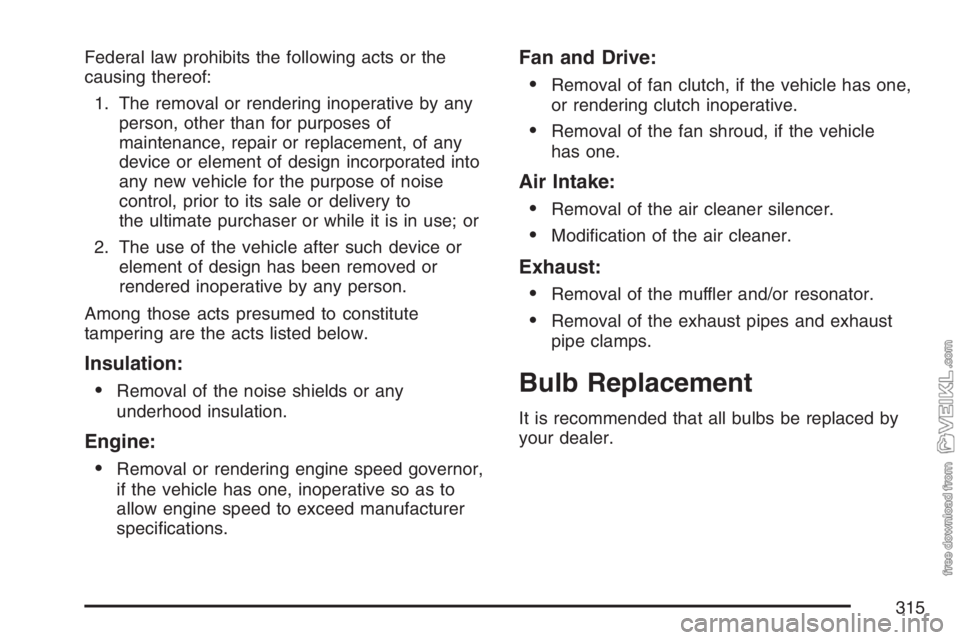
Federal law prohibits the following acts or the
causing thereof:
1. The removal or rendering inoperative by any
person, other than for purposes of
maintenance, repair or replacement, of any
device or element of design incorporated into
any new vehicle for the purpose of noise
control, prior to its sale or delivery to
the ultimate purchaser or while it is in use; or
2. The use of the vehicle after such device or
element of design has been removed or
rendered inoperative by any person.
Among those acts presumed to constitute
tampering are the acts listed below.
Insulation:
•
Removal of the noise shields or any
underhood insulation.
Engine:
•
Removal or rendering engine speed governor,
if the vehicle has one, inoperative so as to
allow engine speed to exceed manufacturer
specifications.
Fan and Drive:
•
Removal of fan clutch, if the vehicle has one,
or rendering clutch inoperative.
•Removal of the fan shroud, if the vehicle
has one.
Air Intake:
•
Removal of the air cleaner silencer.
•Modification of the air cleaner.
Exhaust:
•
Removal of the muffler and/or resonator.
•Removal of the exhaust pipes and exhaust
pipe clamps.
Bulb Replacement
It is recommended that all bulbs be replaced by
your dealer.
315
Page 316 of 430
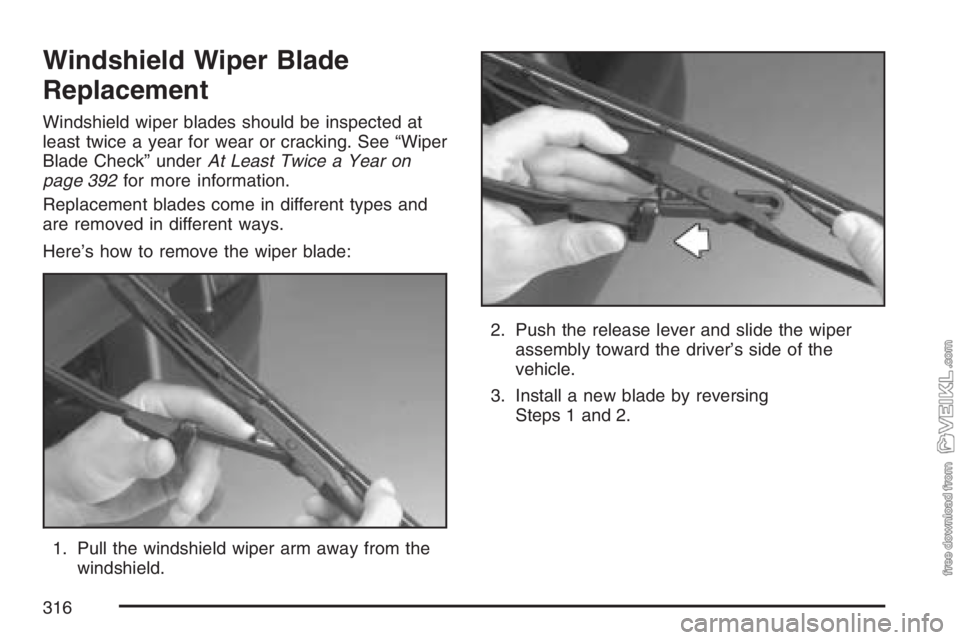
Windshield Wiper Blade
Replacement
Windshield wiper blades should be inspected at
least twice a year for wear or cracking. See “Wiper
Blade Check” underAt Least Twice a Year on
page 392for more information.
Replacement blades come in different types and
are removed in different ways.
Here’s how to remove the wiper blade:
1. Pull the windshield wiper arm away from the
windshield.2. Push the release lever and slide the wiper
assembly toward the driver’s side of the
vehicle.
3. Install a new blade by reversing
Steps 1 and 2.
316
Page 317 of 430
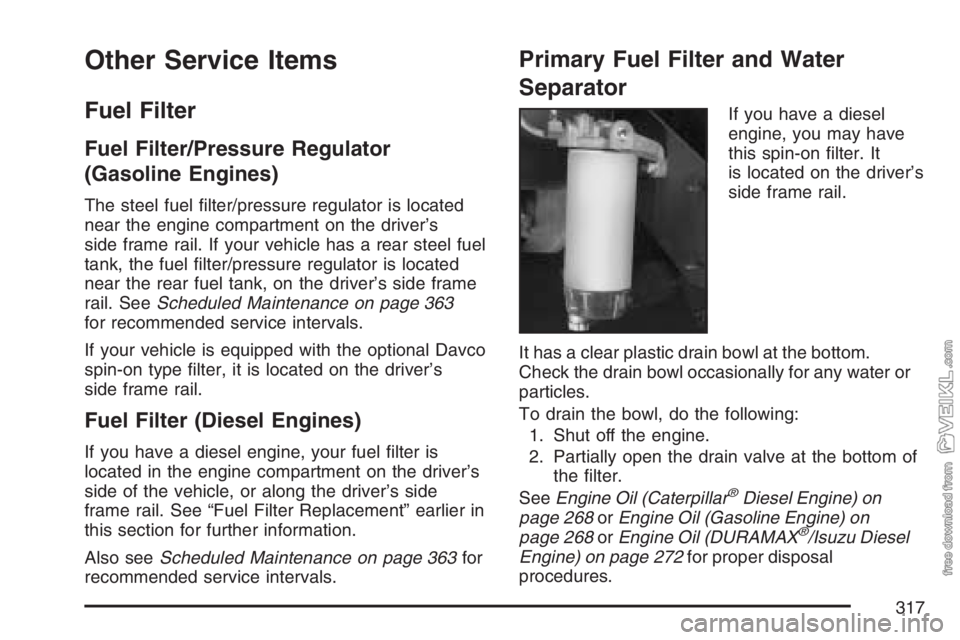
Other Service Items
Fuel Filter
Fuel Filter/Pressure Regulator
(Gasoline Engines)
The steel fuel filter/pressure regulator is located
near the engine compartment on the driver’s
side frame rail. If your vehicle has a rear steel fuel
tank, the fuel filter/pressure regulator is located
near the rear fuel tank, on the driver’s side frame
rail. SeeScheduled Maintenance on page 363
for recommended service intervals.
If your vehicle is equipped with the optional Davco
spin-on type filter, it is located on the driver’s
side frame rail.
Fuel Filter (Diesel Engines)
If you have a diesel engine, your fuel filter is
located in the engine compartment on the driver’s
side of the vehicle, or along the driver’s side
frame rail. See “Fuel Filter Replacement” earlier in
this section for further information.
Also seeScheduled Maintenance on page 363for
recommended service intervals.
Primary Fuel Filter and Water
Separator
If you have a diesel
engine, you may have
this spin-on filter. It
is located on the driver’s
side frame rail.
It has a clear plastic drain bowl at the bottom.
Check the drain bowl occasionally for any water or
particles.
To drain the bowl, do the following:
1. Shut off the engine.
2. Partially open the drain valve at the bottom of
the filter.
SeeEngine Oil (Caterpillar
®Diesel Engine) on
page 268orEngine Oil (Gasoline Engine) on
page 268orEngine Oil (DURAMAX
®/Isuzu Diesel
Engine) on page 272for proper disposal
procedures.
317
Page 318 of 430
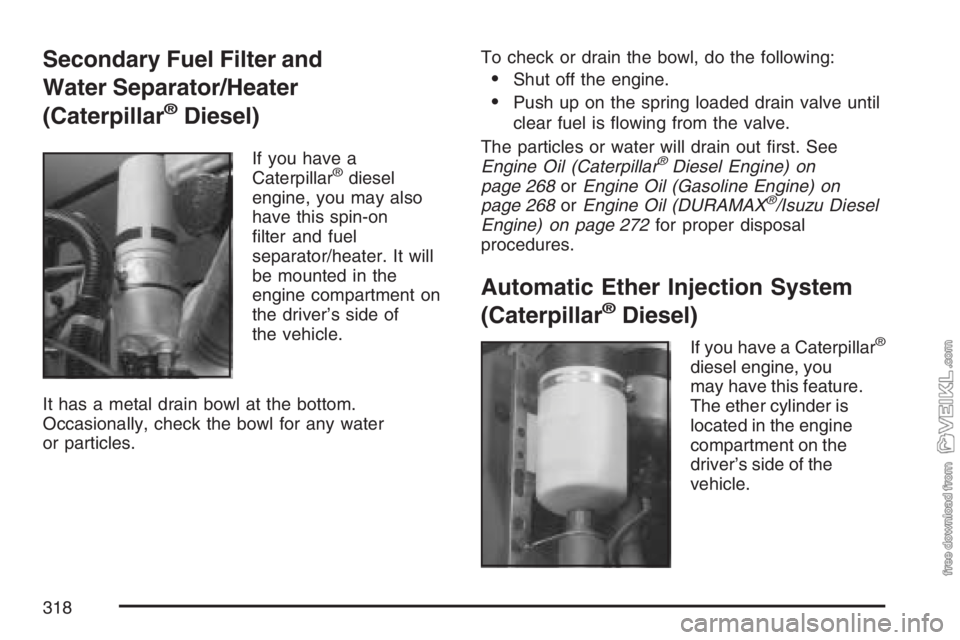
Secondary Fuel Filter and
Water Separator/Heater
(Caterpillar
®Diesel)
If you have a
Caterpillar®diesel
engine, you may also
have this spin-on
filter and fuel
separator/heater. It will
be mounted in the
engine compartment on
the driver’s side of
the vehicle.
It has a metal drain bowl at the bottom.
Occasionally, check the bowl for any water
or particles.To check or drain the bowl, do the following:
•Shut off the engine.
•Push up on the spring loaded drain valve until
clear fuel is flowing from the valve.
The particles or water will drain out first. See
Engine Oil (Caterpillar
®Diesel Engine) on
page 268orEngine Oil (Gasoline Engine) on
page 268orEngine Oil (DURAMAX
®/Isuzu Diesel
Engine) on page 272for proper disposal
procedures.
Automatic Ether Injection System
(Caterpillar
®Diesel)
If you have a Caterpillar®
diesel engine, you
may have this feature.
The ether cylinder is
located in the engine
compartment on the
driver’s side of the
vehicle.
318
Page 319 of 430
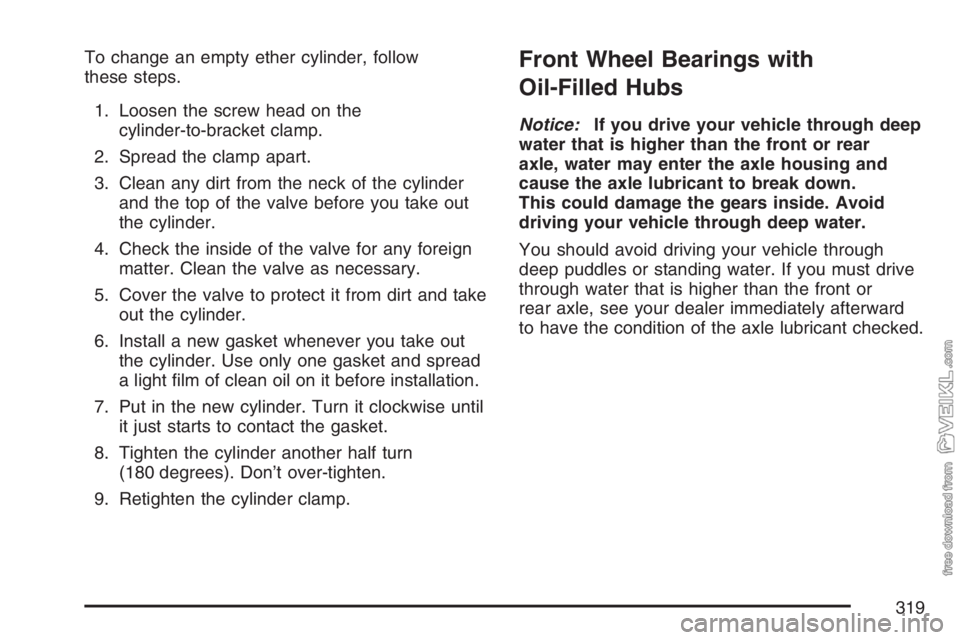
To change an empty ether cylinder, follow
these steps.
1. Loosen the screw head on the
cylinder-to-bracket clamp.
2. Spread the clamp apart.
3. Clean any dirt from the neck of the cylinder
and the top of the valve before you take out
the cylinder.
4. Check the inside of the valve for any foreign
matter. Clean the valve as necessary.
5. Cover the valve to protect it from dirt and take
out the cylinder.
6. Install a new gasket whenever you take out
the cylinder. Use only one gasket and spread
a light film of clean oil on it before installation.
7. Put in the new cylinder. Turn it clockwise until
it just starts to contact the gasket.
8. Tighten the cylinder another half turn
(180 degrees). Don’t over-tighten.
9. Retighten the cylinder clamp.Front Wheel Bearings with
Oil-Filled Hubs
Notice:If you drive your vehicle through deep
water that is higher than the front or rear
axle, water may enter the axle housing and
cause the axle lubricant to break down.
This could damage the gears inside. Avoid
driving your vehicle through deep water.
You should avoid driving your vehicle through
deep puddles or standing water. If you must drive
through water that is higher than the front or
rear axle, see your dealer immediately afterward
to have the condition of the axle lubricant checked.
319
Page 320 of 430
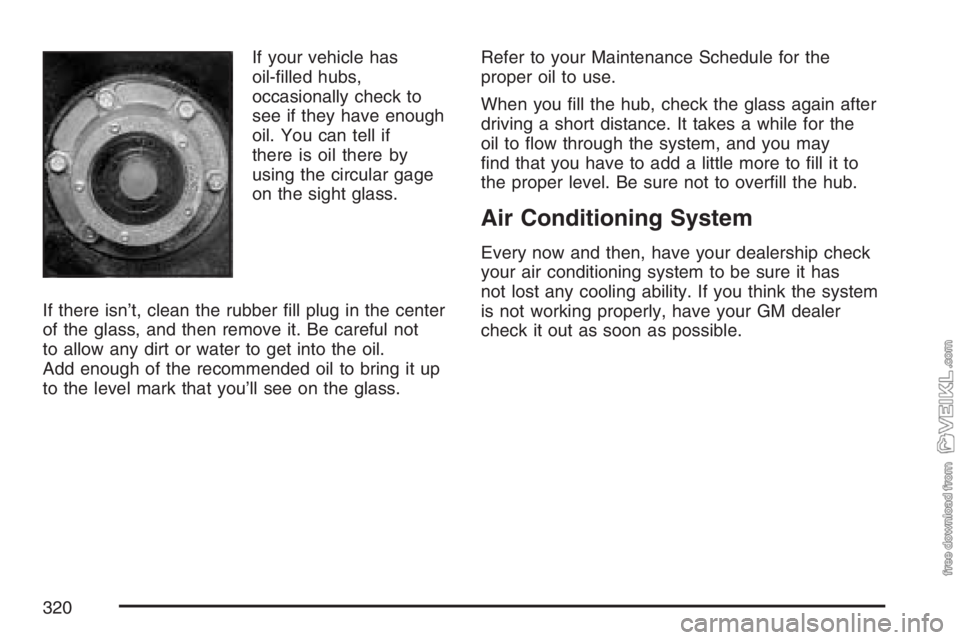
If your vehicle has
oil-filled hubs,
occasionally check to
see if they have enough
oil. You can tell if
there is oil there by
using the circular gage
on the sight glass.
If there isn’t, clean the rubber fill plug in the center
of the glass, and then remove it. Be careful not
to allow any dirt or water to get into the oil.
Add enough of the recommended oil to bring it up
to the level mark that you’ll see on the glass.Refer to your Maintenance Schedule for the
proper oil to use.
When you fill the hub, check the glass again after
driving a short distance. It takes a while for the
oil to flow through the system, and you may
find that you have to add a little more to fill it to
the proper level. Be sure not to overfill the hub.
Air Conditioning System
Every now and then, have your dealership check
your air conditioning system to be sure it has
not lost any cooling ability. If you think the system
is not working properly, have your GM dealer
check it out as soon as possible.
320